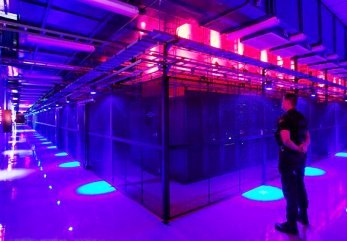Here’s one symptom of a growing problem:
“Jeff Rothschild’s machines at Facebook had a problem he knew he had to solve immediately. They were about to melt.
“The company had been packing a 40-by-60-foot rental space here with racks of computer servers that were needed to store and process information from members’ accounts. The electricity pouring into the computers was overheating Ethernet sockets and other crucial components. Thinking fast, Mr. Rothschild, the company’s engineering chief, took some employees on an expedition to buy every fan they could find “…to blast cool air at the equipment and prevent the Web site from going down.”

“Today,” The New York Times writes (Sept. 22), “the information generated by nearly one billion people requires outsize versions of these facilities, called data centers, with rows and rows of servers spread over hundreds of thousands of square feet, and all with industrial cooling systems.”
More than a year ago, my ever-vigilant, super-heterodyne, computer specialist Kyle tells me, “Jim, you’ve got to get an off-site back-up. You need to get in ‘the Cloud.’ ”
Thanks to Carbonite, I enjoy the added assurance that, as well as having a portable hard-drive for daily backups, I have a reliable online system designed to automatically back up all my computer files – from text to spreadsheets, music and photos.
Sounds pretty good, doesn’t it? Except for one tiny detail, actually a rather big detail. There are “tens of thousands of data centers that now exist to support the overall explosion of digital information.”
That’s right, all those movies, music, text files, spreadsheets, e-mails, iTunes, online retail accounts, texts, tweets – anything, everything digital is stored not in some invisible cloud in the sky, but millions of servers in secured warehouses throughout the country.
And what is the one thing they depend upon most…power, a LOT of power.
“Most data centers, by design, consume vast amounts of energy in an incongruously wasteful manner, interviews and documents show. Online companies typically run their facilities at maximum capacity around the clock, whatever the demand. As a result, data centers can waste 90 percent or more of the electricity they pull off the grid, The Times found.”
And here’s what made my head explode.
“Worldwide, the digital warehouses use about 30 billion watts of electricity, roughly equivalent to the output of 30 nuclear power plants, according to estimates industry experts compiled for The Times. Data centers in the United States account for one-quarter to one-third of that load, the estimates show.
“ ‘It’s staggering for most people, even people in the industry, to understand the numbers, the sheer size of these systems,’ said Peter Gross, who helped design hundreds of data centers. ‘A single data center can take more power than a medium-size town.’ ”
Think about all those “vital” tweets and e-mails that may go bouncing around the internet, but are stored, apparently forever.
“Energy efficiency varies widely from company to company. But at the request of The Times, the consulting firm McKinsey & Company analyzed energy use by data centers and found that, on average, they were using only 6 percent to 12 percent of the electricity powering their servers to perform computations. The rest was essentially used to keep servers idling and ready in case of a surge in activity that could slow or crash their operations.”
Imagine keeping your car running 88 percent of the time, making it instantly available for driving to work or a quick run to the market.
“A few companies,” The Times writes, “say they are using extensively re-engineered software and cooling systems to decrease wasted power. Among them are Facebook and Google, which also have redesigned their hardware. Still, according to recent disclosures, Google’s data centers consume nearly 300 million watts and Facebook’s about 60 million watts.”
Then there’s the storage side of the problem.
“Jeremy Burton, an expert in data storage, said that when he worked at a computer technology company 10 years ago, the most data-intensive customer he dealt with had about 50,000 gigabytes in its entire database. (Data storage is measured in bytes. The letter N, for example, takes 1 byte to store. A gigabyte is a billion bytes of information.) Today, roughly a million gigabytes are processed and stored in a data center during the creation of a single 3-D animated movie, said Mr. Burton… the New York Stock Exchange, produces up to 2,000 gigabytes of data per day that must be stored for years, he added.”
What’s the solution?
Along with initiating better systems to manage both the energy and space usage, each of us needs to rethink just how we use the digital universe in much the same way we think about using any resource. Do we really need to send and save that e-mail or text message so much that we’re willing to justify the use of all that power?
The problem is likely to get a lot worse before it gets better. My guess is that when we reach the point where demand for more power and space becomes so high, higher prices will force all of us to prioritize just what we really need to have in that cloud – a mega data center that may be coming to your neighborhood soon.
Comments










